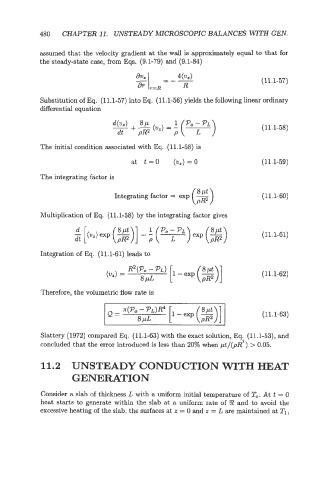Page 500 - Modelling in Transport Phenomena A Conceptual Approach
P. 500
480 CHAPTER 11. UNSTEADY MICROSCOPIC BfiANCES WITH GEN.
assumed that the velocity gradient at the wall is approximately equal to that for
the steady-state case, from Eqs. (9.1-79) and (9.1-84)
(11.1-57)
Substitution of Eq. (11.1-57) into J2q. (11.1-56) yields the following linear ordinary
differential equation
1 Po-PL )
d(v,) +--(a)=-( (1 1.1-58)
8P
dt pR2 P
The initial condition associated with Eq. (11.1-58) is
at t =O (v,) = 0 (1 1.1-59)
The integrating factor is
(i;:)
Integrating factor = exp - (11.1-60)
Multiplication of Eq. (11.1-58) by the integrating factor gives
(11.1-61)
Integration of Eq. (11.1-61) leads to
(11.1-62)
Therefore, the volumetric flow rate is
Slattery (1972) compared Eq. (11.1-63) with the exact solution, Eq. (11.1-53), and
concluded that the error introduced is less than 20% when pt/(pR2) > 0.05.
11.2 UNSTEADY CONDUCTION WITH HEAT
GENERATION
Consider a slab of thickness L with a uniform initial temperature of To. At t = 0
heat starts to generate within the slab at a uniform rate of ?J2 and to avoid the
excessive heating of the slab, the surfaces at z = 0 and z = L are maintained at TI,

